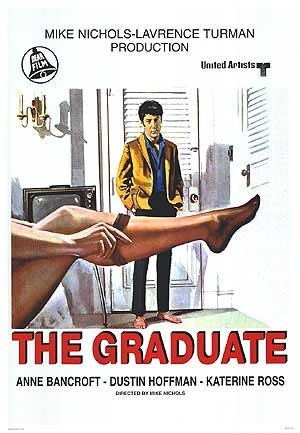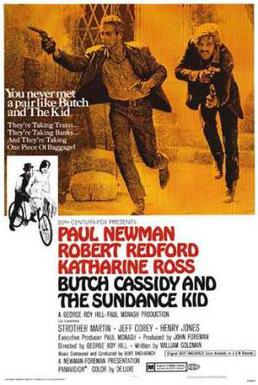The Graduate:
 A Movie Review
A Movie Review
The graduate is a very odd movie, and one I personally did not like very much, but there are a lot of things the movie does really well, so this review will be containing my personal biases, but I have made sure to include the things the movie did well.Plot:
The story follows Ben (Dustin Hoffman) a recent college graduate that doesn't know what he wants to do with his life, and his only "friends" are his parent's friends. His dad's partner's wife Mrs. Robinson (Anne Bancroft) soon comes to him, and essentially wants to have an affair with him, at first Ben denies her in surprise and disgust, but eventually warms up to the idea as he sees this as a way to be different and a way to get away from his over-controlling parents. Eventually Mrs.Robinson's Daughter Elaine (Katharine Ross) comes home from Berkley and Ben falls for her, and then comes the consequence of Ben's actions. His parents want him to go out with Elaine, but since he was having an affair with Mrs. Robinson, Mrs. Robinson tells him to never go out with her daughter. Eventually Ben's rebellious youth kicks in and denies Mrs. Robinson, eventually leading to his determination creating a rift in the Robinson family since he had an affair with Mrs. Robinson, causing the family to divorce. This would be nice if it just ended there, but it goes on, and the second half of the movie, I dislike as it drags on and on. Basically the second half is Ben's escapades to get Elaine to marry him, as both of them are running off of young rebellion motives. This is a real issue since Ben caused Elaine's family to divorce, and no character has a sensible motivation in my eyes, but that could just be me. This long segment with obvious plot twists eventually leads to Ben crashing Elaine's planned wedding in rather over the top fashion. and both Ben and Elaine run away, to a bus where their smiles slowly fade as they realize what they did while they rebelled against their parents' control. This plot was a real oddity to me, and is mainly what put me off of this movie, but it isn't a bad plot, beyond the second half, and it could appeal to certain audiences.Sound & Cinematography:
Being a 90's movie, this has a very oppressive celebrity band soundtrack, this one by Simon & Garfunkel. However this movie uses their songs quite well, with “The Sound of Silence” playing at the beginning of the movie, the beginning of the affair, and the end scene of the movie, and “Mrs. Robinson” being played when Ben was driving to Berkley. it isn't all good choices however, as songs like “Scarborough Fair” were played repeatedly throughout the second half of the movie, which is another reason I did not like the second half, as the song never seemed to signify any kind of emotional connection, or symbolism; However “The Sound of Silence” works really well as a tool of symbolism, showing the lead up to a bad decision, a bad decision, and the outcome of a bad decision in the three times it is played in the movie, and the use of “Mrs. Robinson” is amazing, as it symbolizes Ben's rebellion against the authority of Mrs. Robinson's words, and his obliviousness to the pain he has caused.The cinematography of this movie is fairly gimmicky, with clever first person perspective of the scene where Ben is in scuba gear (which is a completely pointless scene other than to show how controlling his parents are as this does not come up again in the movie) and the symbolism of the Robinson's faces being half shadowed to show how not all is known about them until Mrs. Robinson explains it midway through the first half. Also I believe that any scene where air bubbles in water were present, it symbolized Ben thinking about his life, which is a nice touch, but isn't explored much beyond the first half, mainly because there really isn't any water after the first half, but at the same time he had made his choice in the second half, so it could still be symbolizing the same thing.
All of these techniques work to show how Ben is perceiving the world around him, as he blocks out certain sounds/people, this also gets shown by some pieces of speech being muted in scenes, and the world's oppressive nature muting Ben (quite literally in some of the very early scenes). If there was one thing I truly enjoyed about this movie, it was how director Mike Nichols manipulated each of the elements to give the audience a clear idea of what Ben was thinking/feeling at all times, where that is good, there was a lot less of these mutings in the last half of the movie up until the climax, which was rather jarring to me, as it made the portions where Ben was at Berkley to get Elaine to love him seem disjointed from the creative movie that it happened to be in.
Verdict:
Overall I didn't like this movie very much, but it does have a lot of appeal for audiences. Honestly I found myself face-palming throughout the entire movie at the dumb decisions the characters make, but that could be the entire idea of the movie. I suggest watching the movie in order to make an opinion of it, as not everyone will have my pessimistic viewpoint of the movie.Rating:
Give it a watch.-Conner Baker
Sources Referenced:
"The Warning Sign." The Warning Sign. N.p., 5 Sept. 2011. Web. 21 Nov. 2013. <http://twscritic.com/2011/09/05/movie-project-5-the-graduate-1967/>.
Prince, Stephen. Movies and meaning: an introduction to film. Sixth Edition ed. Boston: Allyn and Bacon, 2004. Print
The Graduate. Dir. Mike Nichols. Perf. Dustin Hoffman, Anne Bancroft, Katharine Ross. Embassy Pictures, 1967. Film.

